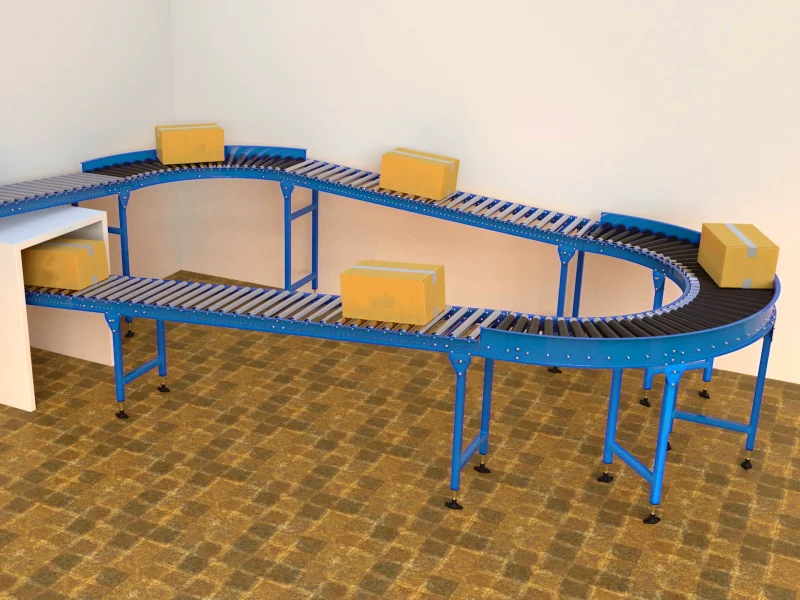
Heavy Duty Gravity Roller Conveyor
Our heavy duty gravity roller conveyors rely on gravity (via a slight incline) or manual push to move heavy loads, such as pallets or large industrial items, without powered motors, making them cost-effective and low-maintenance for specific applications. Below is a comprehensive guide on heavy-duty gravity roller conveyors, covering their design, components, selection process, pricing, etc.
What is a Heavy-Duty Gravity Roller Conveyor?
A heavy-duty gravity roller conveyor is a non-powered conveyor system designed to transport heavy loads—typically 500 to 5,000 lbs or more—using gravity or manual force. Rollers, mounted on a sturdy frame, allow loads to move along a slight incline (1–5°) or level surface. These roller conveyor systems are ideal for applications where powered systems are unnecessary or cost-prohibitive, such as short-distance transport, staging, or loading/unloading in warehouses or manufacturing facilities. They are robust, low-maintenance, and suited for heavy items like pallets, drums, or machinery parts.
Key Features
- Load Capacity: Supports heavy loads (500–5,000 lbs+), with large-diameter rollers (2.5"–3.5") and reinforced frames made of heavy-gauge steel or aluminum.
- Non-Powered: This type of unpowered roller conveyor relies on gravity (via incline) or manual push, eliminating electricity costs and motor maintenance.
- Durability: Built for rugged environments, with options like galvanized or stainless steel for corrosion resistance.
- Simplicity: Minimal moving parts (rollers, bearings) reduce complexity and upkeep
- Applications: Warehousing (pallet staging), manufacturing (assembly lines), distribution (loading docks), and heavy industrial tasks.
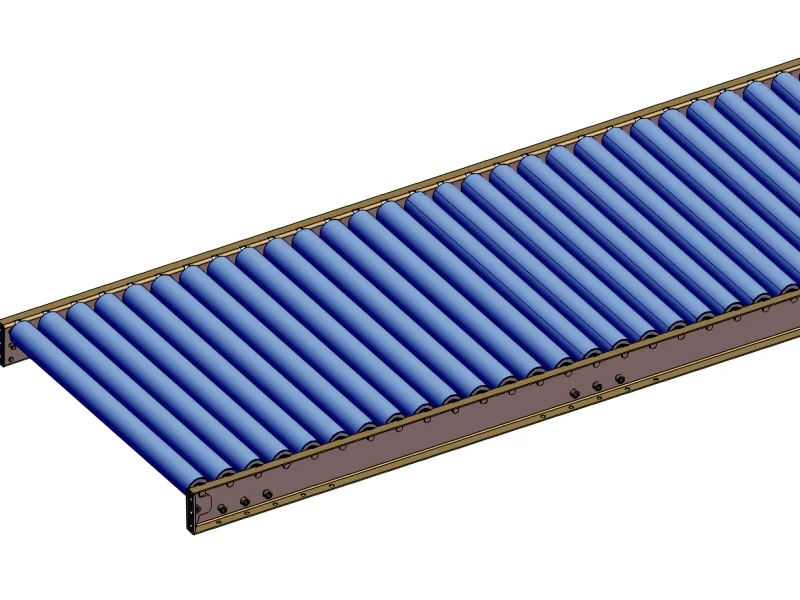
This is a section of gravity roller conveyor for easy packing.
Key Components
Gravity Rollers
- Function: Support and facilitate load movement; rotate freely on bearings.
- Specifications:
- Diameter: 2.5"–3.5" for heavy-duty (larger for greater capacity).
- Material: Steel (galvanized for rust resistance), stainless steel (food-grade), or reinforced plastic (rare).
- Length: Matches conveyor width (e.g., 48"–60" for pallets).
- Roller Spacing: 3"–6" centers; loads must span 3+ rollers for stability.
- Bearings: Heavy-duty, precision, or sealed for high loads and durability.
Conveyor Frame
- Function: Supports rollers and load weight; maintains structural integrity.
- Material: Heavy-gauge steel (powder-coated or galvanized), aluminum (lighter but less common), or stainless steel (washdown).
- Effective Width: Load width + 4"–6" margin (e.g., 48" pallet = 54" frame).
- Height: 12"–36" (low-profile for pallets, adjustable for alignment).
- Supports: Legs or stands every 5–10 feet, reinforced for heavy loads.
Side Rails
- Function: Guide loads, prevent derailment, and enhance safety.
- Types:
- Fixed: 4"–8" high, steel, for pallets or stable loads.
- Adjustable: For varying load sizes.
- Roller Guides: Rare, for delicate loads.
- Material: Steel, aluminum, or stainless steel.
Common Accessories
- End Stops: Prevent loads from rolling off (e.g., fixed or spring-loaded).
- Brakes/Dampers: Control speed on inclines for heavy loads.
- Floor Locks: Stabilize portable conveyors.
- Guides: Center loads on wide conveyors.
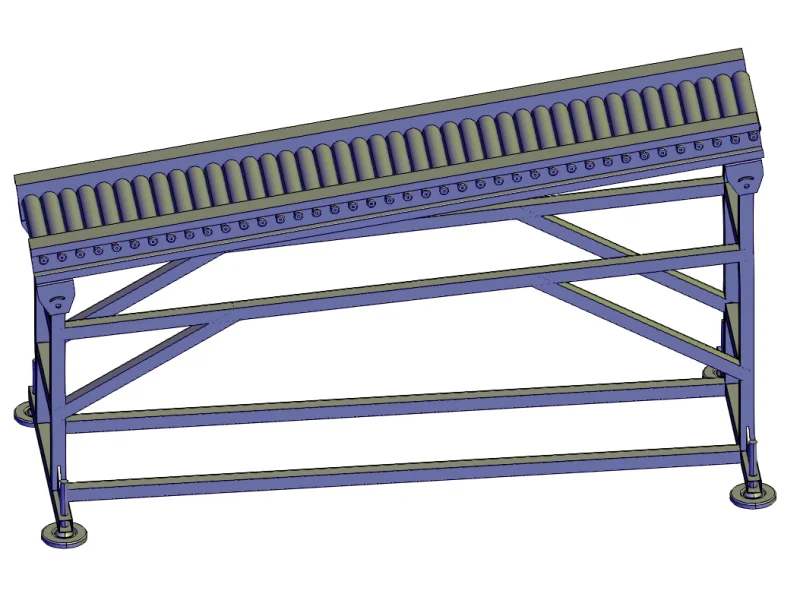
This is a gravity roller conveyor system with easy installing footprint.
Design Considerations
Load Capacity
- Range: 500–5,000 lbs (e.g., pallets, drums).
- Roller Rating: Each roller supports 500–2,000 lbs (e.g., 10 rollers at 1,000 lbs each = 10,000 lbs total).
- Frame Strength: Must exceed load weight (e.g., 5,000-lb load needs 6,000-lb frame rating).
Incline Angle
- Range: 1–5° (e.g., 1° = ~2" drop over 10'; 5° = ~10" drop).
- Heavy loads (e.g., 1,000 lbs+): 1–2° to control speed.
- Lighter loads (e.g., 500 lbs): 2–3° for momentum.
- Testing: Start shallow (1°) and adjust to avoid runaway or stalling.
Roller Spacing
- Rule: Loads span 3+ rollers (e.g., 48" pallet needs 12"–16" spacing).
- Typical: 3"–6" centers; closer for unstable or runner-based pallets.
Conveyor Layout
- Straight: Common for short runs (5'–50').
- Curved: Tapered rollers for turns (rare in heavy-duty gravity). We can offer gravity type curved roller conveyor system.
- Length: Modular sections (5' or 10') for flexibility.
Environment
- Dry/Indoor: Galvanized steel rollers/frames.
- Washdown/Food-Grade: Stainless steel, sealed bearings.
- Outdoor/Harsh: Galvanized or coated steel for corrosion resistance.
Safety Features
- Side Rails: 4"–8" high to prevent pallet derailment.
- End Stops: Mandatory to catch loads at the end.
- Brakes: For speed control on inclines with heavy loads.
How to Choose a Heavy-Duty Gravity Roller Conveyor
Define Application Requirements
- Load: E.g., 2,000-lb pallets (48" x 40") or 1,000-lb drums.
- Purpose: Staging, loading/unloading, or short transport.
- Distance: E.g., 10'–20' run.
- Flow: Gravity (incline) or manual push (level).
Select Roller Specifications
- Diameter: 2.5"–3.5" for heavy loads.
- Spacing: 3"–6" (e.g., 4" for 48" pallets).
- Material: Steel (standard), stainless steel (food-grade).
- Bearings: Heavy-duty or sealed for durability.
Determine Frame and Width
- Width: Load width + 4"–6" (e.g., 48" pallet = 54" conveyor).
- Frame: Heavy-gauge steel for strength; stainless steel for washdown.
- Height: 12"–18" for forklift access or 24"–36" for ergonomics.
Set Incline and Supports
- Incline: 1–2° for heavy loads (e.g., 2"–4" drop over 10').
- Supports: Every 5–10 feet, adjustable for incline.
Choose Side Rails and Accessories
- Side Rails: Fixed steel, 4"–6" high for pallets.
- End Stops: Heavy-duty to catch 2,000-lb+ loads.
- Brakes: Optional for speed control.
Factor in Environment
- Indoor: Galvanized steel.
- Food-grade: Stainless steel.
- Outdoor: Coated or galvanized components.
Budget and Maintenance
- Cost: $500–$3,000 per 10' section.
- Maintenance: Minimal; inspect rollers/bearings quarterly, clean as needed.
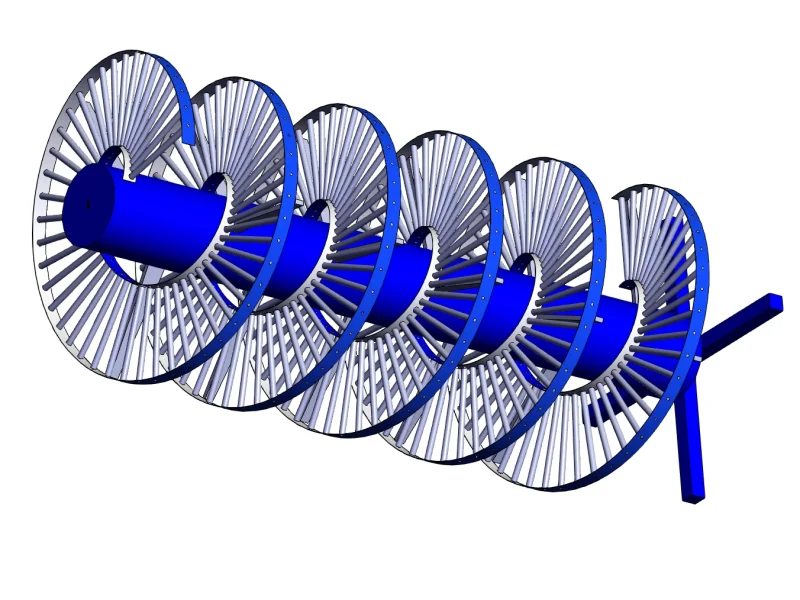
This is a spiral gravity roller conveyor for warehouse.
Pricing of Heavy Duty Gravity Roller Conveyor
Heavy-Duty Gravity Roller Conveyor:
- Standard (48"–60" wide, 2.5" rollers): $500–$2,000 for 10'.
- High-capacity (54"–72" wide, 3.5" rollers): $1,000–$3,000 for 10'.
- Example: 15' x 54" for pallets ≈ $1,500–$2,500.
Key Components:
- Rollers: Steel (2.5"): $10–$30 each; stainless steel (3.5"): $20–$50.
- Bearings: Heavy-duty, $5–$15 each.
- Frame Sections: Steel (10'): $200–$500.
- Side Rails: Steel (4"–6" high): $10–$20/ft; stainless steel: $15–$50/ft.
- End Stops: $10–$50 each.
- Brakes/Dampers: $50–$200 each.
- Spares: Budget $100–$300 for rollers, bearings, and rails per 10' section.
Maintenance Tips
- Rollers: Inspect bearings quarterly for noise or wear; replace if damaged.
- Frame: Check for dents or rust; clean in washdown environments.
- Side Rails: Ensure no loose bolts or damage; replace if bent.
- Incline: Verify angle (1–2°) for consistent flow; adjust if loads stall or run away.
- Spares: Keep rollers and bearings on hand for quick repairs.
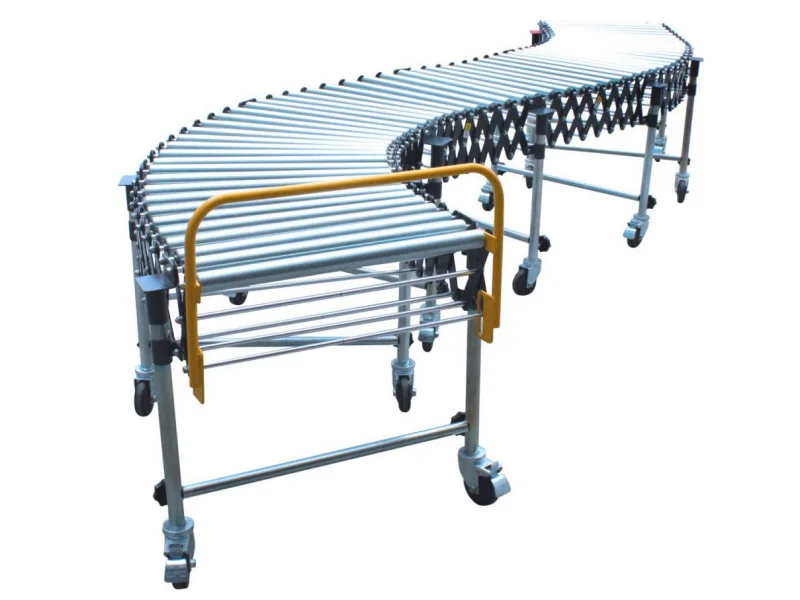
This is a flexible gravity roller conveyor for easy and temporary layout.
Comparison with Heavy-Duty Powered Roller Conveyors
| Items | Gravity Type | Powered (Chain-Driven/Motorized) Type |
| Pros | Low cost ($500–$3,000), no electricity, minimal maintenance, simple design. | Precise control, handles long distances, supports automation, no incline needed. |
| Cons | Limited control (incline-dependent), not suited for long distances or automation, manual push required on level surfaces. | Higher cost ($3,000–$15,000), electricity and maintenance costs. |
| Best For | Short runs, staging, loading/unloading, cost-sensitive applications. | Continuous transport, heavy automation, complex layouts. |
| Our Offering | We can offer gravity roller conveyor and flexible gravity roller conveyor system. | We can offer powered roller conveyor and flexible powered roller conveyor system. |
Example Specification
15' heavy-duty gravity roller conveyor for 2,000-lb pallets (48" x 40").
- Width: 54" (48" + 6").
- Rollers: 2.5" steel, 4" spacing (pallet spans 12 rollers).
- Frame: Heavy-gauge steel, 18" height (forklift-friendly).
- Incline: 1.5° (~3.5" drop over 15').
- Side Rails: Fixed steel, 6" high.
- Accessories: End stop, floor locks.
- Cost: $1,500–$2,500 (conveyor); $150–$300 (spares: 5 rollers, 10 bearings, 5' rail).
Heavy-duty gravity roller conveyors are cost-effective, durable solutions for moving heavy loads (500–5,000 lbs) over short distances, costing $500–$3,000 per section. Key components include 2.5"–3.5" steel rollers, heavy-gauge frames, and side rails. They're ideal for pallet staging or loading/unloading in rugged environments. If you need a specific design, component focus (e.g., roller sizing), or pricing for a particular setup, share details (e.g., load, length, application), and I'll refine the response!


Leave Me Your Requirement!